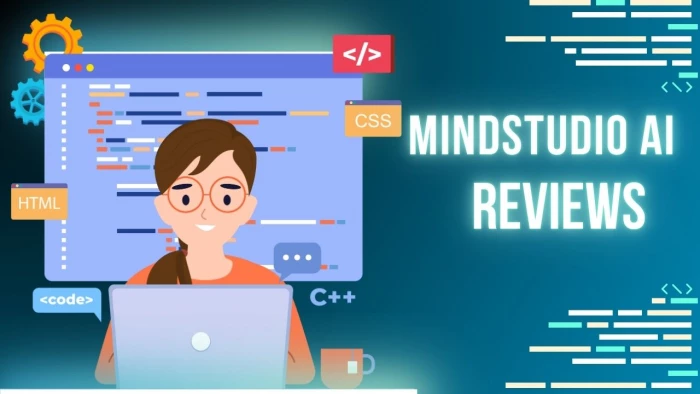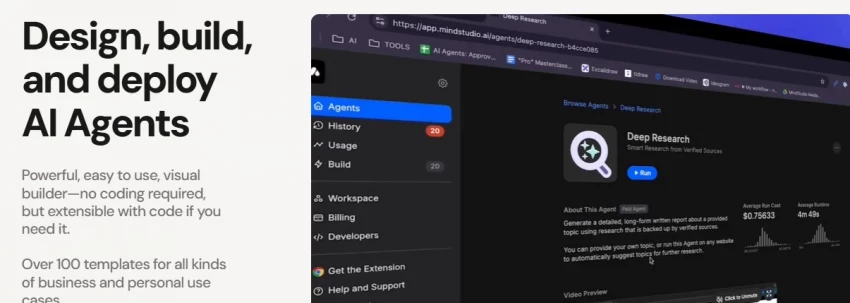

Most of us don’t have time to learn Python or fine-tune machine learning models. Yet, businesses and individuals need AI agents that actually solve real problems — from customer support to research. That’s where MindStudio comes in. It promises a no-code way to create AI-powered apps in minutes.

Reviews across Product Hunt, G2, and even press like TechRadar suggest it’s more than hype. But is it really worth your time? Let’s break it down.
At its heart, MindStudio is a visual builder for AI agents. Instead of writing code, you drag and connect “blocks” — think of them as Lego pieces for automation. One block could pull text from Google Docs, another could run that text through GPT-4, and another could send the answer to Slack.
Unlike other no-code tools that lock you into one AI model, MindStudio lets you choose from multiple providers — OpenAI, Anthropic, Google Gemini, or even open-source LLaMA. That flexibility means you’re not stuck with one ecosystem, which is a huge win for teams balancing cost and accuracy.
This flexibility is the foundation, but what do real users and reviewers actually say when they put it to work?
When TechRadar tried MindStudio, they managed to build a working AI app in just ten minutes — proof that the “no-code” claim isn’t just marketing. CNET found it handy for building a research assistant, saving hours of manual work.
On the crowd-review side, Product Hunt users rate it 4.7/5, calling it “simple yet powerful.” G2 reviews echo the praise but mention a learning curve for first-timers.
These reviews line up with real-life scenarios — and that’s what makes MindStudio interesting. But before exploring use cases, it helps to know what you’ll actually pay for it.
MindStudio offers Free, Starter, Pro, and Agency plans. The free plan is great for testing, letting you publish one app with limited monthly runs. As you scale up, Pro and Agency plans give you more agents, collaborators, and advanced integrations.
What really makes pricing stand out is that MindStudio doesn’t mark up AI model usage costs. You pay exactly what the model provider (like OpenAI or Anthropic) charges — nothing extra. For startups or small businesses watching budgets closely, this transparency is refreshing.
And if you’re wondering whether it’s worth upgrading, that depends on where MindStudio fits best.
Agencies: Deliver client-facing AI tools (like chatbots or FAQ assistants) in days instead of weeks.
Marketing teams: Automate repetitive content workflows and campaign tasks without pulling in IT.
Students and researchers: Summarize long documents or generate study material instantly.
Small businesses: Build support bots that answer customer questions 24/7 without hiring extra staff.
These are situations where speed and simplicity matter more than raw technical depth. But if you’re a developer who loves tinkering, there are trade-offs to keep in mind.
For teams that want deep customization, fine-tuning, or complete control over model behavior, frameworks like LangChain are better. Similarly, AI labs that experiment with their own data pipelines might find no-code limiting.
That said, MindStudio does try to bridge the gap with integrations, but there’s still a small learning curve for absolute beginners — let’s unpack that next.
While the interface is beginner-friendly, some users on G2 mentioned it took a few trial runs to really “get it.” That’s fair — even drag-and-drop builders require you to think in workflows.
Thankfully, MindStudio invests in onboarding: tutorials, webinars, and even a Slack community for quick support. Once you’ve built your first project, the workflow logic clicks into place. And from there, updates only make it easier.
MindStudio keeps rolling out new features:
These updates show that the tool isn’t standing still — it’s evolving with the AI ecosystem. But to decide if it’s right for you, it helps to see how it stacks up against alternatives.
| Feature / Tool | MindStudio | LangChain | Voiceflow |
| Approach | No-code drag & drop builder | Code-first Python framework | No-code, chat design focused |
| Best For | Non-technical teams, SMBs, agencies | Developers, data scientists | Teams building chatbots or assistants |
| Model Support | Multiple providers (OpenAI, Anthropic, Gemini, LLaMA) | Any, full control | Mostly GPT-style models |
| Ease of Use | Beginner friendly | (Dev skills needed | Conversation-specific |
| Pricing | Transparent, pay-as-you-go usage | Free (open source) but infra costs | Subscription model |
| Customization | Medium (workflows, APIs) | High (full coding flexibility) | Medium (focused on conversations) |
| Ideal Use Case | Quick AI apps, automations, research agents | Complex pipelines, enterprise AI infra | Chatbots, CX design |
This table shows the trade-offs clearly: MindStudio is the fastest way to start, LangChain gives ultimate control, and Voiceflow is best for conversational flows.
These aren’t just hypotheticals — they’re exactly the kinds of examples highlighted in CNET and TechRadar reviews.
After analyzing reviews, features, and real-world use, here’s how we scored it:
| Category | Score (out of 5) | Why It Matters |
| Ease of Use | ⭐⭐⭐⭐☆ (4.0) | Easy to build workflows, slight learning curve. |
| Features & Integrations | ⭐⭐⭐⭐⭐ (5.0) | Covers most real-world needs. |
| Pricing Transparency | ⭐⭐⭐⭐⭐ (5.0) | No hidden markups on usage. |
| Community & Support | ⭐⭐⭐⭐☆ (4.0) | Helpful, though smaller than open-source. |
| Overall Value | ⭐⭐⭐⭐☆ (4.0) | Great fit for non-technical teams. |
This scorecard shows MindStudio isn’t perfect, but it’s a strong choice for its intended audience.
Pros
Cons
So, is it worth adopting? Let’s wrap it up.
If you’re a business, student, or agency looking for speed and simplicity, MindStudio is a strong contender in 2025. It gives you professional-level AI agents without needing a developer on hand.
If you need to tinker with code or want to control every single model parameter, you’ll probably lean toward frameworks like LangChain. But for most everyday workflows — research assistants, content helpers, customer bots — MindStudio strikes the right balance.
Does MindStudio mark up AI usage?
No — you pay what the provider charges.
Can I bring my own API key?
Yes, it’s optional.
Is it enterprise secure?
Yes, it’s SOC 2 and GDPR compliant.
How many agents can I publish?
Free = 1, Pro and Agency = multiple.
Be the first to post comment!